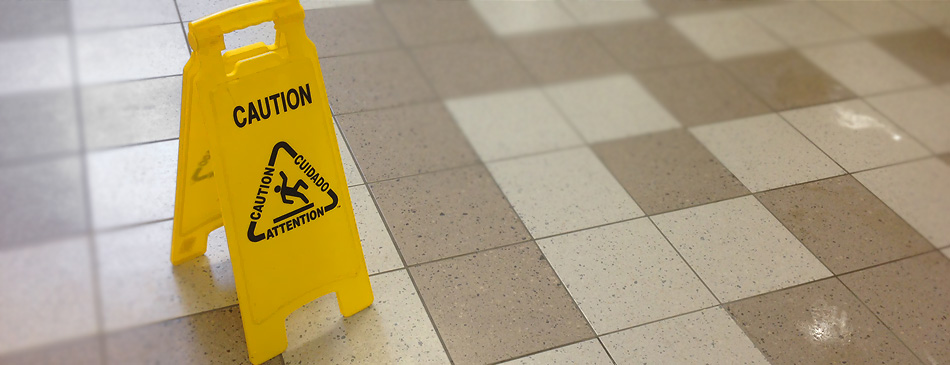Getting A Grip On Safety
New Standards Target Slip-and-Fall Hazards
by Larry Brenner
[image caption=”As published originally in Canadian Property Management Magazine” title=”” alt=””]http://marblerenewal.ca/wp-content/uploads/2014/09/aspublished.jpg[/image]
[/fancy_images]
View article as PDF.[/fancy_box]
The CosT of slIp-and-fall accidents has been pegged at nearly $80 billion each year in North America – a tally that is expected to grow as the population ages. In response, the American National Standards Institute (ANSI), in collaboration with the National Floor Safety Institute (NFSI), has published standards to help property managers and business owners implement or improve programs governing floor safety.This will likely have implications for building owners who don’t have such programs in place. Plaintiff attorneys representing slip-and-fall victims may be able to argue negligence if there’s no documentation to demonstrate due diligence in implementing a safe floor program to protect workers, residents and visitors.Independent floor audits can provide building owners and managers with evidence of compliance. Audits can also identify high-risk areas and walkway surfaces that require additional maintenance or restoration.In the United States, the Occupational Safety & Health Administration (OSHA) is expected to introduce a new ruling pertaining to walkways, which will necessitate record-keeping of cleaning practices and periodic testing for slip-resistance to maintain certain levels of COF (coefficient of friction). Employers will have to designate a “qualified person” to oversee floor safety, who will be responsible for measuring slip-resistance and determining what steps may be needed to improve a floor’s traction.
Measuring the COF eliminates subjectivity, and gives property owners/managers a scientific measurement to determine whether their cleaning products and procedures are increasing or decreasing the likelihood of slip-and-fall accidents. The biggest mistakes made with regard to floor care are using improper products and employing the wrong techniques.
Audits identify high-risk areas and walkway surfaces that require additional maintenance or restoration.
An independent traction audit is one of the initial steps in the development of any safe floor program to establish the baseline for safe floor initiatives by providing operators with an accurate assessment of the current condition of floor surfaces. Audits should be conducted using an NFSI-approved tribometer, a device that measures the coefficient of friction of the floor surface – i.e. the amount of friction that occurs between two surfaces when rubbed together.A complete audit should document both the static and dynamic coefficient of friction. The static test measures the slip-potential of a surface or the degree of likelihood that a pedestrian will slip as his or her heel strikes the floor. The dynamic test identifies how far the individual is likely to slide after the point of the initial slip.The auditor is required to test a variety of locations as part of a comprehensive audit, including entryways and exits, high-traffic pathways and restroom entrances. Floor safety experts recommend conducting ongoing traction audits throughout the life of the safe floor program – at least twice a year. Risk tolerance also helps determine audit frequency, so locations with higher traffic or floor surface substrates prone to slips and falls should be audited more often.Owners/managers should ensure auditors have the required qualifications to perform the task, such as NFSI certification or accreditation from another recognized floor safety organization. Auditors should be familiar with protocol established in the ANSI B101 standards and should use an NFSI-approved tribometer.
Safety Fundamentals
Upon completion of the initial audit, managers and operators should review floor maintenance programs currently in place as this is often an area for improvement. A floor safety program includes three fundamental components to maintain floor surfaces.
Deep Clean
Daily vacuuming and mopping reduces dirt and various particles in the floor, but they fail to capture and remove all contaminants. Floors become worn out over time, and grout lines that were once grey become black from dirt build-up. Periodic deep cleanings revive floors to enhance the image of the building and protect all people walking across the area.Deep cleaning combines temperature, agitation, chemicals, time and extraction to remove dry dirt and residue left behind by conventional cleaning methods. With restored floors, operators promote a positive image for everyone who enters the building and demonstrate a commitment to cleanliness and safety.A traction treatment program enhances the finish of natural stone or manmade-tile floors commonly found in commercial properties to improve slip resistance and provide high traction. Trained professionals apply a specialized cleaning chemical across the floor to loosen the dirt and contaminants then agitate the surface using a soft-to-medium hardness brush.
Matting
Although entranceway matting plays a significant role in preventing accidental slips by removing moisture from footwear, they can contribute to trips and falls when buckled, curled or flipped over. Mats should be strategically placed to capture dirt and water, and reduce slips and falls. Mats that do not have a high-traction backing are more prone to movement, which, in turn, can increase the risk of migration, buckling and curling that can contribute to a slip, trip and fall. In 2012, ANSI released the latest in its series of walkway safety standards, the ANSI/NFSI B101.6-2012 Standard Guide for Commercial Entrance Matting in Reducing Slips, Trips and Falls, which provides criteria for the selection, installation, inspection, care and maintenance of entrance mats and runners in commercial facilities. It focuses on reducing slips, trips and falls through the elimination of hazards such as soil, moisture, contaminants, as well as edge treatments and the improper use of floor mats and runners. A growing number of entrance mat manufacturers have submitted their products to the NFSI for certification.
Daily Floor Maintenance
Provide ongoing training so employees know how to properly clean floors, and reinforce cleaning frequencies with checklists so other team members know exactly when and where the floors were last cleaned. This is essential to a clean and safe environment.

